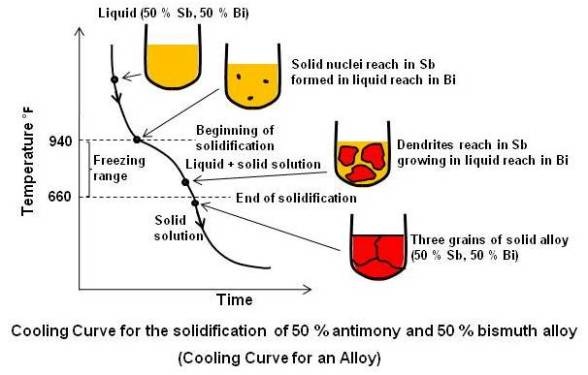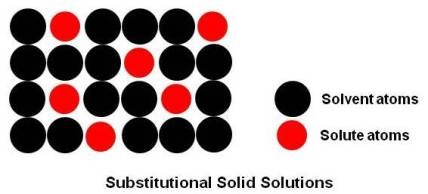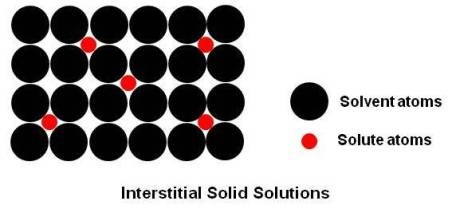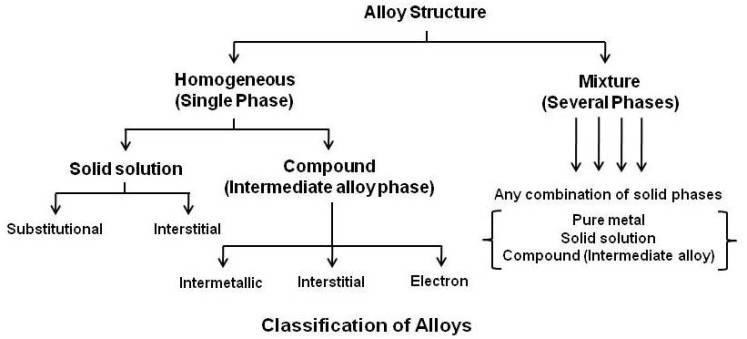Only a few elements are widely used commercially in their pure form. Generally, other elements are present to produce greater strength, to improve corrosion resistance, or simply as impurities left over from the refining process. The addition of other elements into a metal is called alloying and the resulting metal is called an alloy. Even if the added elements are nonmetals, alloys may still have metallic properties. Alloys may be classified according to their structure and complete alloy systems may be classified according to type of their equilibrium or phase diagram. Information about classification of alloys according to their structure is given in this article.
Classification of Alloys
An alloy system contains all the alloys that can be formed by several elements combined in all possible proportions. If the system is made up of two elements, it is called binary alloy system; three elements, ternary alloy system; etc.
Mixture refers to the physical combination of two or more substances. Mixtures are either homogeneous or heterogeneous. A homogeneous mixture is a type of mixture in which the composition is uniform. This is in contrast to a substance that is heterogeneous. A chemical compound is a pure chemical substance consisting of two or more different chemical elements that can be separated into simpler substances by chemical reactions.
Alloys may be homogeneous (uniform) or mixtures.
If the alloy is homogeneous, it will consist of single phase, and if it is a mixture it will be a combination of several phases.
A phase is anything which is homogeneous and physically distinct. Thus a phase is a region of space, throughout which all physical properties (density, tensile strength, etc.) of a material, its chemical composition and structure are uniform.
The uniformity of an alloy phase is not determined on an atomic scale but on a larger scale. Any structure which is visible as physically distinct microscopically is considered a phase. It may be remembered that a single grain consists of only one phase (in a grain, crystal structure is same and is chemically homogeneous). However a phase may contain one or more components.
Since different states of a matter (such as solid, liquid, gas, plasma, etc.) are having distinct properties, each state is a phase. For most pure elements, the term phase is used as a synonymous with state.
Some metals are allotropic in solid state and will therefore have different solid phases. When a metal undergoes a change in crystal structure, it undergoes a phase change since each type of crystal structure is physically distinct. For example, when iron first solidifies at 2800° F, it is in the b.c.c. (body centered cubic) δ (delta) form. Upon further cooling, at 2554° F, a phase change occurs and the atoms rearrange themselves into the γ (gamma) form, which is f.c.c. (face centered cubic) and nonmagnetic and so on.
The criteria for number of phases in a state are as under.
For solids: Chemically and structurally distinct
For liquids: Miscibility
For gases: Always 1 phase.
In the solid state there are three possible phases:
- Pure metal
- Compound or intermediate alloy phase and
- Solid solution
Thus if an alloy is homogeneous (composed of a single phase) in the solid state, it can be only a solid solution or a compound. If the alloy is a mixture, it is then composed of any combination of the phases available in the solid state. It may be mixture of two pure metals, or two solid solutions, or two compounds, or a pure metal and a solid solution, and so on.
Pure Metal
Characteristics of a pure metal are discussed in the article titled crystallization. Under equilibrium conditions, all metals show a definite melting or freezing point.

If a cooling curve is plotted for a pure metal, it will show a horizontal line at the melting or freezing point as shown in above figure.
Compounds
In many binary alloy systems, when the chemical affinity of elements is great, their mutual solubility becomes limited and compounds (also called intermediate phases) are formed (rather than solid solutions).
When compound is formed, the elements loose their individual identity and characteristic properties to a large extent. Water (H2O) is composed of elements that are normally gases at room temperature, yet the compound is liquid at room temperature. The compound will have its own characteristic physical, mechanical and chemical properties.
Most compounds, like pure metals, also exhibit a definite melting point within narrow limits of temperature. Therefore, the cooling curve for a compound is similar to that for a pure metal. It is then referred to as a congruent melting phase. The compounds generally have a crystal structures different from those of pure components of which they are composed.
Information about three most common compounds is given below.
Intermetallic Compounds or Valency Compounds
They are generally formed between chemically dissimilar metals and are combined by following the rules of chemical valence. Since they have strong bonding (ionic or covalent), their properties are essentially nonmetallic. They usually show poor ductility and poor electrical conductivity and may have a complex crystal structure. Examples of valency compounds are Mg2Pb, Cu2Se, etc.
Interstitial Compounds
They are formed between the transition metals such as Sc, Ti, Ta, W and Fe with hydrogen, oxygen, carbon, boron and nitrogen. The word interstitial means between the spaces. The latter five elements have relatively small atoms that fit into the spaces of the lattice structure of the metal. The interstitial compounds are metallic, may have narrow range of composition, high melting points, and are extremely hard. Examples are Fe4N, Fe3C, W2C, CrN, etc.
Electron Compounds
In alloys of copper, gold, silver, iron and nickel with the metals cadmium, magnesium, tin, zinc, and aluminum, a number of compounds are formed. For example – AgCd, Ag5Cd8 and AgCd3 are formed in alloys of silver with cadmium. They have a definite ratio of valence electrons to atoms and are therefore called electron compounds. The electron-atom ratios for the alloys of silver with cadmium are as under.
| Compound | Electron-Atom Ratio | Crystal Structure |
|---|---|---|
| AgCd | 3:2 | Body centered cubic |
| Ag5Cd8 | 21:13 | Complex cubic |
| AgCd3 | 7:4 | Close packed hexagonal |
Many electron compounds have properties resembling those of solid solutions, including a wide range of composition, high ductility, and low hardness.
Solid Solutions
Solubility is the property of a solid, liquid or gaseous chemical substance where solute (minor part) dissolves in a solvent (major part) to form a homogeneous solution. The solvent is a chemical substance and can be in a solid, liquid or gaseous state. Thus solution can exist in a gaseous, liquid or solid state.
The amount of solute that may be dissolved by the solvent is generally a function of temperature (with pressure constant) and usually increases with increasing temperature.
There are three possible conditions for a solution: unsaturated, saturated and supersaturated. If the solvent is dissolving less of the solute than it could dissolve at a given temperature and pressure, it is said to be unsaturated. If it is dissolving the limiting amount of solute, it is saturated. If it is dissolving more of the solute than it should, under equilibrium conditions, the solution is supersaturated. A solution can be made supersaturated by doing work on the solution, such as stirring, or preventing equilibrium conditions by rapidly cooling the solution. The supersaturated condition is an unstable one, and given enough time or a little energy, the solution tends to become stable or saturated by rejecting or precipitating the excess solute.
A solid solution is simply a solution in the solid state and consists of two kinds of atoms combined in one type of space lattice (space lattice of solvent, at times called matrix. it may be noted that since the solution has only one type of space lattice, it has one phase). When solidification of the solution starts, the temperature may be higher or lower than the freezing point of the pure solvent. Most solid solutions solidify over a range in temperature.

Above figure shows the cooling curve for a solid solution alloy containing 50 % Sb (antimony) and 50 % Bi (bismuth). It may be noted that this alloy begins to solidify at temperature lower than the freezing point of pure antimony (1170° F) and higher than the freezing point of pure bismuth (520° F).
Depending on the atom size and solute and solvent elements, two types of solid solutions may be formed – substitutional and interstitial.
Substitutional solid solutions

As shown in the above figure, in this type of solution, some of the solvent atoms are substituted by atoms of the solute (alloying element) atoms. Several factors are now known largely through the work of Hume-Rothery that control the range of solubility in the alloy system as under.
Of all factors, relative-size factor is the most important. Solute atom need to “fit†in place of solvent atom. For this, ï€ solute and solvent atomic radii should be within ~ 15%. The size factor is favorable for solid solution formation (maximum solubility) when the difference in atomic radii is less than about 15 percent (d = 0.85 D, where d is diameter of solute atom and D is diameter of solvent atom). If the relative size factor is greater than 8 percent but less than 15 percent, the alloy system usually shows a minimum solubility (d = 1.08 D to 1.15 D). If the relative size factor is greater than 15 percent, solid solution formation is very limited (d > 1.15D). It is important to note that an unfavorable relative-size factor alone is sufficient to limit solubility to a low value.
Complete solid solubility of two elements is never attained unless the elements have the same type of crystal lattice structure.
The greater the chemical affinity of two metals, the more restricted is their solid solubility and greater is the tendency towards compound formation .Generally, the further apart the elements are in the periodic table, the greater is their chemical affinity.
If the solute metal has a different valency from that of the solvent metal, the number of valency electrons per atom, called the electron ratio, will be changed. Crystal structures are more sensitive to a decrease in the electron ratio than to an increase. A metal of lower valency tends to dissolve more of a metal of higher valency than vice versa. For example, in the aluminum-nickel alloy system, nickel is lower in valency than aluminum. In this case, solid nickel dissolves 5 percent aluminum, but the higher valency aluminum dissolves only 0.04 percent nickel.
The lattice structure of a solid solution is basically that of the solvent with slight changes in lattice parameters. An expansion occurs if the solute atom is larger than the solvent atom and a contraction if the solute atom is smaller.
Interstitial Solid Solutions
These are formed when atoms of small atomic radii fit into the spaces or interstices of the lattice structure of the larger solvent atoms as shown in figure given below.

Since the spaces of the lattice structure are restricted in size, only atoms with radii less than one angstrom are likely to form interstitial solid solutions. These are hydrogen, boron, carbon, nitrogen and oxygen.
Interstitial solid solutions normally have very limited solubility and generally are of little importance. Carbon in iron is a notable exception and forms the basis for hardening steel.
In both type of solid solutions, distortion of the lattice structure will exist in the region of the solute atoms. This distortion will interfere with the movement of dislocations on slip planes and will therefore increase the strength of the alloy. This is the primary basis for the strengthening of a metal by alloying.
The properties of an alloy can be manipulated by varying its composition. For example steel formed from iron and carbon can vary substantially in hardness depending on the amount of carbon added and the way in which it was processed.
In contrast to intermetallic and interstitial compounds, solid solutions in general are easier to separate, melt over a range of temperature, have properties that are influenced by those of the solvent and solute, and usually show a wide range of composition so that they are not expressed by a chemical formula.
A summary of possible alloy structures is shown in the figure given below.

